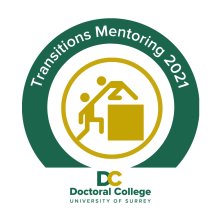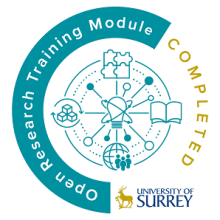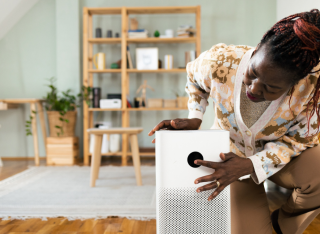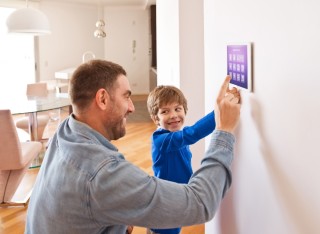
Dr Emily Corrigan-Kavanagh (formerly Corrigan-Doyle)
Academic and research departments
Surrey Institute for People-Centred Artificial Intelligence (PAI), Centre for Vision, Speech and Signal Processing (CVSSP).About
Biography
Research interests & background
I am a design researcher and academic, with special interests in designing people-centred artificial intelligence for wellbeing, home wellbeing, service design, participatory research methods, technology for good, and creative research methods. My expertise include a range of participatory approaches for engaging stakeholders in the design of new technologies such as world cafes, design workshops and in-depth interviews as well as novel implementation of creative research methods, such as photo elicitation and art therapy techniques.
I have published widely on topics such as creative research methods, designing for home wellbeing, assistive technology, service design, enriching travel experiences, sound sensing AI, and AI for home wellbeing. I am also a TEDx speaker, a member of the International Advisory Council for the Design Research Society and of the BSI (British Standards Institution) Technical Committee for Ageing Societies, currently part of the working group for delivering a new ISO (International Standards Organisation) standard for multigenerational neighbourhoods.
I am passionate about exploring design research approaches and methods for delivering new AI technologies and associated services, especially those supporting psychological wellbeing within the home and surrounding community. Relatedly, I am the founder and leader of the special research interest group "Home Wellbeing" at the University of Surrey.
I welcome PhD supervision enquires for projects exploring new design approaches and creative methods for developing new AI technologies and associated services with end-users.
News & events
- 22 November: Presented "A Virtual World Cafe Method for Participatory Design of AI Systems" at Second UK AI Conference 2024, University of Birmingham, UK
- 29-30 October 2024: Facilitated two World Cafe style focus groups exploring future technology design requirements for home wellbeing with local residents in Dumfries, Scotland in collaboration with The Crichton Trust
- 25 June 2024: Presented extended abstract "Designing AI for Home Wellbeing and Future Implications for Healthcare Technologies" at Design4Health, Sheffield, UK
- 18 June 2024: Presented webinar "Exploring Sound Sensing AI for Home Wellbeing through Participatory Design Research" through UK Acoustics Network (UKAN):https://youtu.be/Ht75h0euWFQ
- 13 June 2024: Elected to the Designing Research Society (DRS) International Advisory Committee
- 12 July 2022: Organised and hosted "Designing AI for Home Wellbeing" AI Seminar Day with 10 speakers, including national and international AI experts, at 6G Innovation Centre, University of Surrey, UK
- 11 July 2022: Facilitated "Designing AI for Home Wellbeing" World Cafe with 24 AI experts, University of Surrey, UK
- 30 June 2022: Facilitated "Designing AI for Home Wellbeing" focus group at DRS2022, Bilbao, Spain
- 18 May 2022: Presented bespoke creative method "Happy Homes Workshop" (employing art therapy techniques) at "Envisioning and designing digital technology for the home" workshop held at the Museum of the Home, London
- 14 May 2022: Delivered TEDx talk "Designing AI for Wellbeing"
- 7 March 2022: Led "virtual world cafe" exploring sound sensing technology for workplace wellbeing with 14 UK office-based workers
- 31 January 2022: Appointed member of AHRC Peer Review College to provide expert reviews on AHRC scheme
- 20 January 2022: Invited as guest speaker to deliver presentation on AI4S research to Discover.ai
- 13 December 2021: Winner of Research England Participatory Research Grant (£10K) to explore AI for workplace wellbeing
- 12 December 2021: Appointed Surrey AI Fellow for new People-centred AI Institute to lead pan-University collaboration on AI related research, teaching and innovation
- 6 December 2021: Won IAS Workshop Fund (£3.5) to plan and host "Designing AI for Wellbeing" World Cafe
- 12 November 2021: Hosted "Envisioning Future Homes for Wellbeing" online event
- 2 November 2021: Hosted "Research and Innovation in Technologies for Home Wellbeing" and "Future Technologies for Home Wellbeing" at 5G/6G Innovation Centre, University of Surrey
- 2 September 2021: Named researcher on successful National Cyber Security Centre (NCSE) grant to the Academic Centre of Excellence in Cyber Security Education (ACE-CSE)
- 9 August 2021: Won the EPSRC IAA Commericalisation Fellowship
- 9 August 2021: Won ESRC IAA funding to run two events for the ESRC Festival of Social Sciences
- 22-23 June 2021: Presented poster at Shaping Futures Conference 2021 [Twitter]
- 9 June 2021: Invited talk at UKRI ECR Forum welcome week
- 20 May 2021: Invited talk at Response-ability Summit 2021 [Twitter] [LinkedIn]
- 12 May 2021: Invited talk at the Institute of Sound Recording (IoSR) seminar day
- 22 April: led "virtual world cafe" with 12 Guildford residents to explore directions for new sound sensing technology to improve sounds in urban environments
- 19-21 April 2021: Presented poster at Urban Sound Symposium "Exploring Sound Sensing to Improve Quality of Life in Urban Living"
- 24 Mar 2021: Presented Connected Places Catapult Breakfast Briefing: Enabling Thriving Urban Communities through Sound Sensing AI Technology, with Prof Mark Plumbley [Twitter] [LinkedIn]
- 12 Nov 2020: Invited talk with Prof Mark Plumbley at #LboroAppliedAI seminar series on Applied AI, Univ of Loughborough
Areas of specialism
My qualifications
Affiliations and memberships
Transitions Mentoring Digital Badge
This digital badge recognises that the candidate was a Postgraduate Research Student Mentor for the Researcher Development Programme's Transitions Mentoring scheme. View the transitions mentoring webpage for further information.
News
In the media
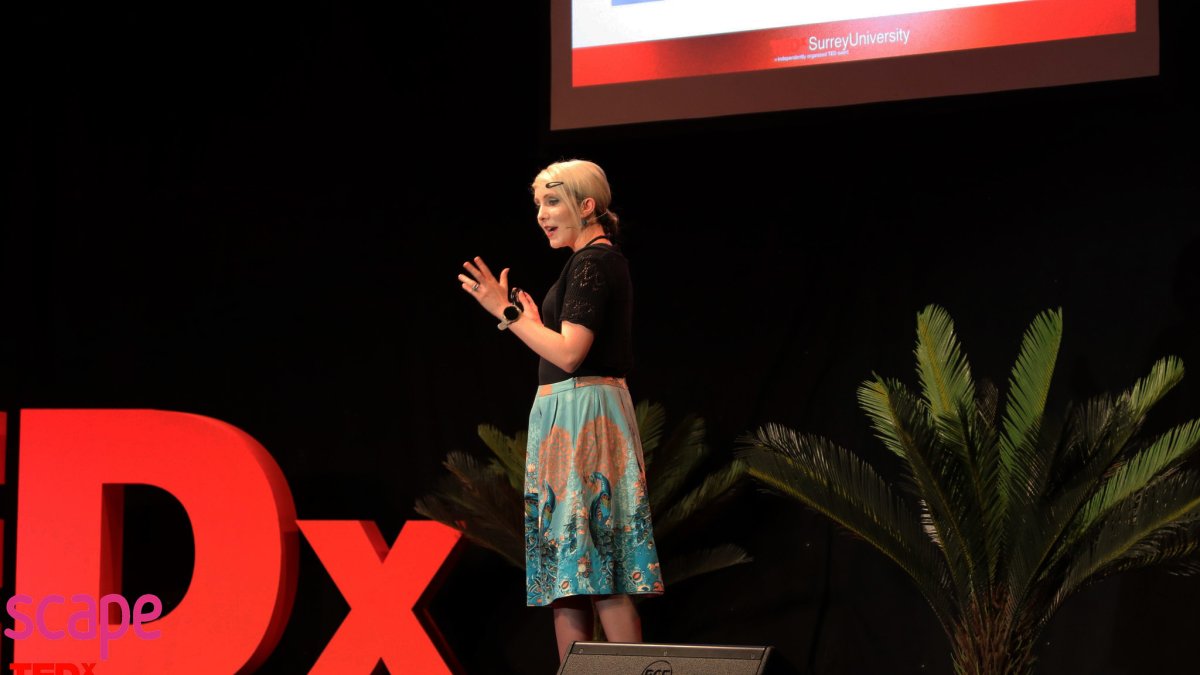
ResearchResearch interests
Designing for Happiness; Designing for Sustainability; Service Design, Designing for Social innovation; Visual Communication; Interaction Design; Design for Cross-Media Platforms and Augmented Paper, Creative Research Methods; Exploring/making sense of subjective experiences
Research projects
This research is part of the Engineering and Physical Sciences Research Council (EPSRC) prestigious Fellowship Award given to the University of Surrey’s Professor Mark Plumbley. Acting as the Research Fellow in Design Research on this project, I am investigating the deployment of sound sensors for assisted living in the home, smart buildings, and for smart cities to facilitate more independent living for individuals with dementia, and healthier working and city environments by alleviating noise pollution for example. This involves the design and undertaking of participatory research engagement activities with stakeholders, such as visits to families in their homes, focus groups, expert panels, listening tests, and soundwalks, with the aim of making design recommendations from the findings of user studies.
The project proposal was in response to a call on ‘Content creation and consumption in the digital economy’. It aims to create new technology and business opportunities in the publishing and tourism industries.
It will do this by using augmented reality and printed electronics to connect paper to the web, in what the team call second generation (2G) and third generation paper (3G). If today’s ordinary paper is considered first generation (1G) paper, then 2G paper will be optically recognised with a camera, triggering associated digital information to be played or displayed on a nearby device.
3G paper will dispense with the camera and contain tiny sensors printed or embedded in the fibres of the paper itself. This will trigger the same kind of associations around it. In this way, paper documents and books could have hotlinks to webpages, audio, video clips and so on that could play on speakers or screens around them. The team will be looking at how this could change and connect the use of paper and screen-based information in tourism, where tourist brochures and guides already co-exist with mobile apps, digital photography and online booking systems.
Research interests
Designing for Happiness; Designing for Sustainability; Service Design, Designing for Social innovation; Visual Communication; Interaction Design; Design for Cross-Media Platforms and Augmented Paper, Creative Research Methods; Exploring/making sense of subjective experiences
Research projects
This research is part of the Engineering and Physical Sciences Research Council (EPSRC) prestigious Fellowship Award given to the University of Surrey’s Professor Mark Plumbley. Acting as the Research Fellow in Design Research on this project, I am investigating the deployment of sound sensors for assisted living in the home, smart buildings, and for smart cities to facilitate more independent living for individuals with dementia, and healthier working and city environments by alleviating noise pollution for example. This involves the design and undertaking of participatory research engagement activities with stakeholders, such as visits to families in their homes, focus groups, expert panels, listening tests, and soundwalks, with the aim of making design recommendations from the findings of user studies.
The project proposal was in response to a call on ‘Content creation and consumption in the digital economy’. It aims to create new technology and business opportunities in the publishing and tourism industries.
It will do this by using augmented reality and printed electronics to connect paper to the web, in what the team call second generation (2G) and third generation paper (3G). If today’s ordinary paper is considered first generation (1G) paper, then 2G paper will be optically recognised with a camera, triggering associated digital information to be played or displayed on a nearby device.
3G paper will dispense with the camera and contain tiny sensors printed or embedded in the fibres of the paper itself. This will trigger the same kind of associations around it. In this way, paper documents and books could have hotlinks to webpages, audio, video clips and so on that could play on speakers or screens around them. The team will be looking at how this could change and connect the use of paper and screen-based information in tourism, where tourist brochures and guides already co-exist with mobile apps, digital photography and online booking systems.
Supervision
Postgraduate research supervision
Jessica Verner (Designing AI for Home Wellbeing with Young People)
Kassie Headon (Inclusive design and AI: Supporting Meaningful Collaboration Between End-Users and Technologists)
Kebing Zhang (Designing a Video Conferencing System To Support Social Connection Between Older Adults and Their Family Members)
Publications
This paper proposes a new design research approach for “Designing Artificial Intelligence (AI) for Home Wellbeing” as a new research field to collaboratively develop AI technologies for home wellbeing with stakeholders, such as end-users, and disciplinary experts, rather than leaving design solely to AI experts. Designing AI for home wellbeing is significant as AI applications progressively aBect home life. AI can identify trends and/or themes from live data, such as of images, video clips, sounds, or text, (Samoili et al. 2021) and is increasingly deployed in the home, such as recognising abnormal activity for security or monitoring occupants’ behavioural patterns for managing physical health (Guo et al. 2019). The home can play a significant part in supporting both psychological and physiological wellbeing through its central role in everyday living. For example, the home can satisfy fundamental physiological needs for wellbeing, such as shelter and security through its physicality, and psychological needs for wellbeing, such as social connection and intimacy, by facilitating communal eating and social interaction between occupants (Corrigan-Kavanagh and Escobar-Tello 2018). Given the strong influence of home on wellbeing, AI for the home should enhance, introduce, or support home wellbeing. However, there currently exists limited research on design methods and approaches for engaging stakeholders, including end-users, and diBerent disciplines in AI development and deployment (Hossain and Ahmed 2021; Delgado, Barocas, and Levy 2022), creating barriers for designing AI for home wellbeing. This paper calls for further scholarship in “Designing AI for Home Wellbeing” while presenting initial findings from research developing this new field.
Designing artificial intelligence (AI) using participatory design (PD) methods is becoming fundamental as AI increasingly augments everyday life. Well documented cases of machine bias, where AI systems informing hiring, loan approvals and prison sentencing have discriminated against people with certain demographics (i.e. gender, race), have highlighted the need to engage end-users in AI design. PD methods show promise in designing AI systems for maximum societal benefits as they allow users to collaborate with researchers and make decisions about how AI systems should be designed. This paper presents a modified virtual world café method, based on the World Café method, as a PD method to identify relevant design requirements for designing AI systems from the beginning of development. Specifically, we describe how this method was developed and used to create design requirements for sound sensing AI for the home with UK-based residents. Findings suggest that the method can be used as a PD method at the beginning of AI system development to define design requirements. The paper concludes with reflections on how the virtual world café method performs as a PD method for designing AI and how findings might be taken forward in future PD research for designing AI systems more generally.
This paper presents an advanced process for designing “a-books”; augmented printed books with multimedia links presented on a nearby device. Although augmented paper is not new, our solution facilitates mass market use through industry standard publishing software that generates the a-book, and regular smartphones that play related digital media by optically recognising its ordinary paper pages through the phone’s built-in camera. This augmented paper strategy informs new classifications of digital content within publication design, enabling new immersive reading possibilities. Complementary affordances of print and digital, and how these are combined and harnessed by a-books in comparison to previous augmented paper concepts are first discussed. Subsequently, an explanation of the workflow for designing a-books is described. The final discussion includes implications for content creators of paper-based publishing, and future research plans.
[...]before capabilities for mass produced printed books were invented, manuscripts were created during two distinctive periods, 'The Monastic' (approximately 400 CE to the twelfth century) and 'Secular Age' (from the end of the twelfth century to late fifteen century);5 in Western Europe, the former mainly focused on diligent copying of religious texts and some ancient Latin works by monastic scriptoriums6 and the latter saw a significant increase in secular works, encouraged by the formation of university libraries and book copying workshops in the later twelfth and early thirteenth century to address growing student requirements.7 An increase in public literacy from surfacing middle classes also created a demand for books on informational (i.e. science, law) and leisure based topics (i.e. novels) during this time.8 Moreover, the book can be said to be mutable through tears and marks evidencing its handling, mistakes found in text replications and additional annotations added. Drawing on early analysis of fourteen one-to-one reading evaluation studies where participants were introduced to and interviewed on how they might use the a-book, we theorise that the a-book could alter: book physicality by encouraging a dedication of print to timeless content that provides tactile navigation and organisation of agile information; discourse through collective reading interactions and personalisation capabilities afforded by virtual and material components; mutability using editable features to transform curated print content into visual markers for storing personal accounts; and temporality through digital facilities that enable capture and curation of multiple user temporality signifiers that can be shared, reinterpreted and modified by subsequent viewers. A-books introduce additional sensory aspects to reading; they achieve this presently mainly using complementary audio and/or video, accessed by either interacting with the pages (e.g. Listen Reader)11 or using specific specialised equipment (e.g. barcode scanner or electronic pen) to activate supplementary associated media (e.g. Books with Voices12 and Leapfrog Tag Reading System).13 QR codes14 are also commonly employed to augment other forms of printed content such as magazines, brochures, leaflets and newspapers, linking readers to web-based videos and related online sites, encouraging fragmented multimedia reading. 'Social media' in this instance refers to a group of internet-hosted applications that support the generation/provision of user-created content, emerging from the philosophical and technological beginnings of Web 2.0-when Internet participants transitioned from passive to co-creators of online platforms through evolving usage and responsive modification from original providers.21 Through practices of co-creation between traditional publishers and end-users in the mutual generation of published content,22 these developments are broadening the physical forms book content can take, the discourses and temporalities it depicts, the way it can mutate, as well as its temporality through platforms supporting additions of multimedia content, online publishing, copying, modification, and reinterpretation, heightening intertextuality.
The photo album emerged in the late 1800s as place to collect portrait photos of visitors to a home, and was later appropriated by Kodak as a visual chronology of family history. With digital photography the album has largely been replaced by online repositories of images shared on social media, and the selective printing of photobooks. In this paper we present a ‘next generation paper’ authoring system for annotating photobooks with multimedia content viewed on a nearby smartphone. We also report the results of a trial of this system, by nine travellers who used it to make augmented photobooks following a trip. These findings show that the augmented physical-and-digital photobook can heighten awareness of the multisensory aspects of travel, enrich memories, and enhance social interaction around photos. The social and technical implications for the future of the photo album are discussed.
New AI technology that can now automatically analyse and recognise everyday real-world sound scenes and events, presenting promising potential applications in environmental sensing and urban living. Specifically, urban soundscape analysis could be used to monitor and improve soundscapes experienced for people in towns and cities, helping to create new strategies for enhancing quality of life through urban planning and development. However, current research use cases are often unrealistic, lacking appropriate end-user feedback and engagement. In response, this research is employing a range of participatory approaches to gather feedback from stakeholders to realise the full potential benefit of “AI for Sound" technology for society and the economy. For example, the world café approach was used to explore how people feel about sounds in their locality and how they would like to change them to direct future research directions of the project. A world café is a participatory approach typically set in a café style environment where participants engage in three 20-minute discussions on a question posed in small groups, ending with a harvest session where everyone collates conclusions drawn from conversations together. In response to the COVID-19 Pandemic, this research employed the world café virtually to engage with residents while adhering to UK national lockdown and social distancing restrictions. This method follows the original world cafe style utilising a video conference tool where virtual Breakout Rooms are used to divide participants into small conversation groups on the same call. This allowed the identification of themes around how people would choose to change their urban sound environments and the contexts that facilitate this to direct future research into associated AI for sound solutions. This presentation reports on some of the highlights from the virtual world cafe and outlines plans for forthcoming research.
Many studies show the possibilities and benefits of combining physical and digital information through augmented paper. Furthermore, the rise of Augmented Reality hardware and software for annotating the physical world with information is becoming more commonplace as a new computing paradigm. But so far, this has not been commercially applied to paper in a way that publishers can control. In fact, there is currently no standard way for book publishers to augment their printed products with digital media, short of using QR codes or creating custom AR apps. In this paper we outline a new publishing ecosystem for the creation and consumption of augmented books, and report the lab and field evaluation of a first commercial travel guide to use this. This is based simply on the use of the standard EPUB3 format for interactive e-books that forms the basis of a new 'a-book' file format and app.
In today's digital world, paper's reason of being is challenged. Yet, studies suggest that books and paper-based objects have advantages ranging from the tactile sensation to information retention and indexing. We have developed a hybrid electronic device, the "a-book," that offers access to up-to-date and pertinent multimedia content as part of the ordinary interaction with a typical hardcover book. The device maintains the look and feel of a conventional book and is connected to the web through an adjunct smart device. Here, we provide a technical project summary of the electronic system for book augmentation. We outline the system's functionality and discuss its manufacturability, prospects, and limitations in the context of current and emerging flexible electronics technologies.
Electronic publishing usually presents readers with book or e-book options for reading on paper or screen. In this paper, we introduce a third method of reading on paper-and-screen through the use of an augmented book (‘a-book’) with printed hotlinks than can be viewed on a nearby smartphone or other device. Two experimental versions of an augmented guide to Cornwall are shown using either optically recognised pages or embedded electronics making the book sensitive to light and touch. We refer to these as second generation (2G) and third generation (3G) paper respectively. A common architectural framework, authoring workflow and interaction model is used for both technologies, enabling the creation of two future generations of augmented books with interactive features and content. In the travel domain we use these features creatively to illustrate the printed book with local multimedia and updatable web media, to point to the printed pages from the digital content, and to record personal and web media into the book.
Paper and digital media, smartphone apps and travel guides for example, are commonly used together by travellers for reliable and up-to-date information. This paper examines how the a-book, an augmented travel guide with complementary multimedia could enrich travel experiences. Using a tailored app, travellers can access, play, and add their own videos, audio, weblinks and digital images to the guide. Results of 14 evaluations studies with UK travellers suggest that it advances concepts of co-creation, facilitates a new reading paradigm, consequently enriching travel performances. This paper provides an initial introductory to these emerging theoretical themes and suggests implications for future research.
This chapter presents the Design for Happiness Framework (DfH) and the Designing for Home Happiness Framework as applicable specific creative methods for this purpose; they provide relevant processes and tools to design for happiness and wellbeing. It also presents a short summary of prevalent creative methods available to designers, such as probes, toolkits and prototypes. The most common creative methods used by designers can be consolidated under the headings: probes, toolkits and prototypes. The chapter also presents a comprehensive review of relevant aspects for designing for happiness and wellbeing to demonstrate a need to specialise methods in this area. The unique design process of DfH combines for the first time elements of holistic sustainable design plus happiness characteristics. However, for the purposes of explaining DfH in a clear manner, the following sections split it into three separate foundations: design approach; design process; and the toolkit.
This article considers the value of making long-term happiness a key priority in designing for the home and how creative methods, art therapy techniques in particular, can be fundamental in this process. It presents different approaches for investigating home happiness by offering an overview of happiness, design and home literature informing the research process, and techniques employed so far. Accordingly, photo elicitation and art therapy techniques are used at different stages of the research to investigate home happiness and locate design directions. This article therefore discusses how these approaches could assist designers in the creation of happy home design interventions, including commercial products, product-service-systems and/or public/community services, and, through this, potentially lead to happier future homes and more sustainable lifestyles.
Following the successful application of AI and machine learning technologies to the recognition of speech and images, computer systems can now automatically analyse and recognise everyday real-world sound scenes and events. This new technology presents promising potential applications in environmental sensing and urban living. Specifically, urban soundscape analysis could be used to monitor and improve soundscapes experienced for people in towns and cities, helping to identify and formulate strategies for enhancing quality of life through future urban planning and development.
Home can play a central role in influencing societal practices, being, among other conceptualisations, a social system supportive of basic and psychological needs. Art therapy techniques can be used for exploring home happiness from this perspective. They appear to enable the identification of systemic facilitators of happy home moments, informing design opportunities. This paper discusses art therapy techniques as a new tailored creative method for exploring this within design research. It begins by describing relevant home and happiness concepts, art therapy techniques and similar creative methods. This is followed by an explanation of how art therapy approaches were used to examine practices for home happiness. Subsequently, research results are highlighted, such as how 'design for home happiness' can create applicable design products and services. Finally, implications of employing art therapy techniques in 'designing for home happiness' are suggested.
Many studies show the possibilities and benefits of combining physical and digital information through augmented paper. Furthermore, the rise of Augmented Reality hardware and software for annotating the physical world with information is becoming more commonplace as a new computing paradigm. But so far, this has not been commercially applied to paper in a way that publishers can control. In fact, there is currently no standard way for book publishers to augment their printed products with digital media, short of using QR codes or creating custom AR apps. In this paper we outline a new publishing ecosystem for the creation and consumption of augmented books, and report the lab and field evaluation of a first commercial travel guide to use this. This is based simply on the use of the standard EPUB3 format for interactive e-books that forms the basis of a new 'a-book' file format and app.
Personal digital media such as photos, music and films play a pervasive part in contemporary life by helping us to remember the past, communicate with each other and represent our identity to others. In this chapter we explore the value of such media for supporting wellbeing in older age, drawing on concepts from literatures on art, reminiscence and music therapy. Theoretically we argue for a new category of assistive technologies involving media creation and consumption to enhance wellbeing. We propose a framework for understanding and designing such assistive media systems which highlights the interaction between media item, author and audience. This framework is then illustrated through early attempts to explore a new kind of digital story therapy for people with dementia in a residential care setting. We conclude with recommendations for the design of future ‘assistive media’ systems and experiences that might enhance not only the lives of people with dementia, but also those around them.
Despite the rise of digital photography, physical photos remain significant. They support social practices for maintaining social bonds, particularly in family contexts as their handling can trigger emotions associated with the individuals and themes depicted. Also, digital media can be used to strengthen the meaning of physical objects and environments represented in the material world through augmented reality, where such are overlaid with additional digital information that provide supplementary sensory context to topics conveyed. This poster therefore presents initial findings from the development of augmented photobooks to create ‘a-photobooks’, printed photobooks that are augmented by travellers with additional multimedia of their trip using a smartphone-based authoring tool. Results suggest a-photobooks could support more immersive engagement and reminiscing of holidays encounters, increasing cognitive, and emotional effects of associated experiences.
Home can influence our happiness through the activities it affords. Furthermore, previous research has indicated commonalities between happy, and sustainable societies but many of current home practices are unsustainable. This research aims to explore design for happiness as a means to future sustainable, and happier domestic lifestyles. This paper discusses the first study in which photo elicitation method was used with home-owning families to locate home happiness triggers. This method elicited photography of two representative days of the participants’ home life. Participants were then questioned in follow-up semi-structured interviews. From this, happiness home needs were conceptualised and connections were drawn to happy sustainable societies. This paper discusses these results and identifies that strong family bonds, facilitated by time relaxing, socialising and pursuing interests together, are core contributors to happier, and sustainable homes. The implications for design for happiness in the home are also discussed and proposed for future work.
The home plays many roles in our daily lives. It provides shelter and a place to rest. It can be viewed as an extension of the self, portraying our hopes and ideals, and where we create our identity within society1. However, contemporary homes are filled with modern appliances that offer few opportunities for creative output or experience, reducing potential for self-reflection and psychological growth. This lifestyle of high consumption and productivity does not correlate with long-term happiness2 but engagement in creativity does3. Furthermore, art creation engages the emotional centres of the brain4 so can potentially be used to investigate and enhance happiness in the home. In particular, art therapy techniques (for example, art making in silence) can be used to trigger and explore positive emotions. Also, service design approaches (for example, experience journey maps) can facilitate the conceptualisation of new experiences, including happier ones. Based in the UK, this research will therefore explore how creativity can contribute to happiness in the domestic space by using approaches from art therapy and service design. A series of workshops, comprising family homeowners and later service designers, guided by the researchers, will use techniques from these fields to investigate how home happiness might be developed/facilitated. The first of these workshops tested the use of art therapy techniques. This paper will present initial findings from this, such as creating the right context for reflective art making, facilitating emotional expression and art making with a focus on positive family time.
Additional publications
Corrigan-Kavanagh, E., Plumbley, M., Green, M. and Fernandez, A. (2021) Exploring Sound Sensing to Improve Quality of Life in Urban Living [Poster]. Exhibited at Urban Sound Symposium 2021 (USS2021) online. 19 April - 21 April 2021.
Corrigan-Kavanagh, E., Scarles, C. and Revill, G. (2020). 'Augmenting Travel Guides for Enriching Travel Experiences', in Proceedings of ENTER2020 International eTourism Conference,The 27th Annual Conference Organized by IFITT, Guildford, UK, 8–10 January. Guildford: E-review of Tourism, pp. 334–348.
Corrigan-Kavanagh, E. and Escobar-Tello, M. C. (2019) ‘Art therapy techniques as a novel creative method for exploring design for home happiness’, J. of Design Research, 16(3/4), pp.175–195.
Corrigan-Kavanagh, E. and Escobar-Tello, M. C. (2019) ‘Creative Methods for Sustainable Design for Happiness and Wellbeing’ in Cain, R. and Petermans A. (eds.) Design for Wellbeing. London: Routledge, pp. 124-137.
Frohlich, M. D, Corrigan-Kavanagh, E., Bober, M. et al. (2019) 'The Cornwall a-book: An Augmented Travel Guide Using Next Generation Paper', The Journal of Electronic Publishing, 22(1), pp. 189–205.
Corrigan-Kavanagh, E. (2019) 'Next Generation Paper', The Writing Platform, March 7. Available at: http://thewritingplatform.com/2019/03/next-generation-paper/ (Accessed: 18th March 2019).
Corrigan-Kavanagh, E. (2018) Exploring Art Therapy Techniques within Service Design as a Means to Greater Home Life Happiness. PhD thesis. Loughborough University.
Corrigan-Doyle, E., Escobar-Tello, M. C. and Lo, K. P. Y. (2016) ‘Alternative pathways to understanding and designing for happiness in the home’, Iterations, 4, pp.16–23.
Corrigan-Doyle, E., Escobar-Tello, M. C. and Lo, K. P. Y. (2016) ‘Exploring Design for Happiness in the Home and Future Implications for Domestic Living’, in Proceedings of DRS 2016, Design Research Society 50th Anniversary Conference, Brighton, UK, 27–30 June.
Corrigan-Doyle, E., Escobar-Tello, M. C. and Lo, K. P. Y. (2016) ‘Using Art therapy techniques to Explore Home Life Happiness’, in Happiness: 2nd Global Meeting, Perspectives on Happiness. Concepts, Conditions and Consequences. Budapest, Hungry, 14–16 March. Leiden: Brill Rodopi, pp.50–63.
Corrigan-Doyle, E., Escobar-Tello, M. C. and Lo, K. P. Y. (2015) ‘Taking a Softer Approach: Using Photo Elicitation to Explore the Home as a System for Sustainability and Happiness’, in Sustainable Innovation 2015: ‘State of the Art’ Sustainable Innovation & Design: Towards Sustainable Product Design: 20th International Conference. University for the Creative Arts, Surrey, 9–10 November. Surrey: The Centre for Sustainable Design, pp. 101–113.
Corrigan-Doyle, E., Escobar-Tello, M. C. and Lo, K. P. Y. (2015) Creating a Service Design for Happy Sustainable Homes Using Art [Poster]. Exhibited at ‘Better by Design’ Design PhD Conference, Lancaster, Lancaster University. 2 July to 3 July 2015.
Corrigan-Doyle, E., Escobar-Tello, M. C. and Lo, K. P. Y. (2015) How Can Service Design and Art Therapy Create Happy Sustainable Homes? [Poster]. Exhibited at DesRes15 PhD Conference, Loughborough Design School, Loughborough University. 1 April 2015.
